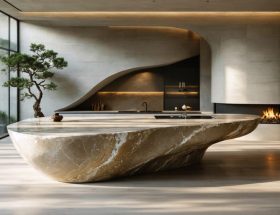Natural stone transforms commercial spaces into enduring statements of quality and sophistication. From the polished granite reception desks that greet clients to the limestone feature walls that define executive suites, natural stone delivers unmatched aesthetic impact while standing up to decades of heavy use.
**Evaluate your project through three critical lenses.** First, assess traffic patterns and durability requirements—granite and quartzite excel in high-traffic lobbies, while marble creates stunning focal points in protected areas. Second, consider maintenance capabilities and lifecycle costs, as proper sealing and routine care determine long-term performance. Third, align stone selection with your brand identity—the material you choose communicates values before a single word is spoken.
**Strategic stone placement maximizes return on investment.** Entry areas, conference rooms, and executive spaces benefit most from natural stone installations, where visual impact justifies premium material costs. These high-visibility zones leverage stone’s inherent authority to elevate brand perception and create memorable client experiences.
**Partner with experienced fabricators and installers early in the design phase.** Professional expertise prevents costly mistakes in material selection, structural requirements, and installation sequencing. The right team transforms architectural vision into reality while navigating building codes, weight loads, and integration with mechanical systems.
This guide examines proven applications, performance data, and real-world case studies to help you make informed decisions about incorporating natural stone into your commercial project.
The Business Case for Natural Stone in Workspaces
First Impressions That Drive Business Results
Your reception area speaks before anyone on your team says a word. When clients, partners, or prospects walk through your entrance, they’re making split-second judgments about your organization’s values, stability, and attention to detail. Natural stone creates an immediate impression of permanence and substance that few materials can match.
Studies in environmental psychology confirm what savvy business leaders intuitively understand: physical environments significantly influence perception and decision-making. A marble or granite lobby doesn’t just look impressive—it communicates investment in quality and long-term thinking. Financial institutions, law firms, and medical practices have long leveraged this psychological advantage, choosing stone for reception desks, feature walls, and flooring specifically because it conveys trustworthiness and established credibility.
The tactile and visual richness of natural stone engages multiple senses simultaneously. The cool smoothness of polished marble, the depth of veining in quartzite, or the dramatic presence of a backlit onyx wall creates memorable experiences that standard materials simply cannot replicate. These aren’t superficial considerations—they’re strategic brand investments that differentiate your space in prospects’ minds.
Working with experienced professional stone installers ensures your entrance makes the precise statement you intend. From selecting the right stone variety to positioning dramatic book-matched slabs, skilled installation transforms raw material into a powerful business asset that continues delivering returns through enhanced client confidence and elevated brand perception for decades.
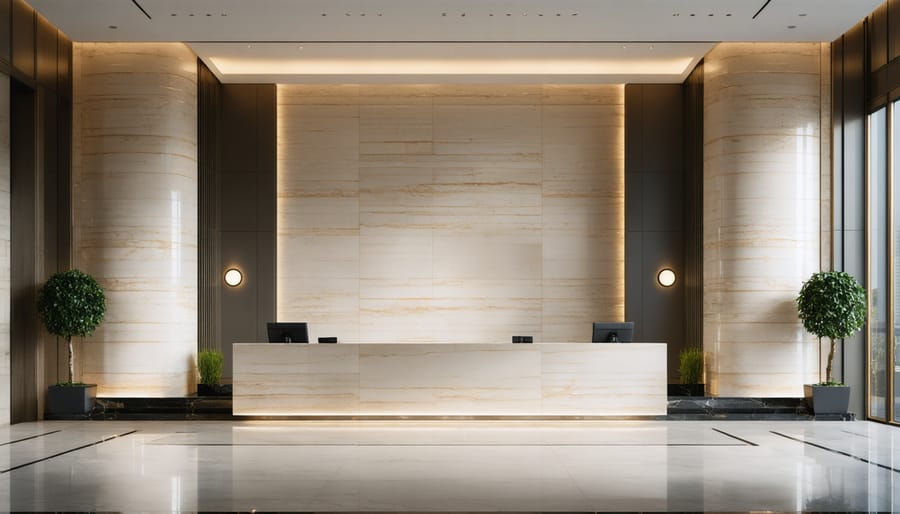
Long-Term Value vs. Initial Investment
While natural stone requires a higher upfront investment than alternatives like porcelain tile or laminate—typically 20-40% more—the lifecycle economics tell a compelling story. Quality stone installations regularly exceed 50-year lifespans with minimal intervention, while synthetic materials often require replacement after 15-20 years.
Consider the true cost trajectory: A commercial lobby floor in granite might cost $45 per square foot installed versus $25 for high-end porcelain. However, over a 20-year period, the granite requires only periodic sealing ($0.50-$1 per square foot every 3-5 years) and occasional professional cleaning. Porcelain alternatives typically need grout replacement, surface refinishing, and higher frequency deep cleaning due to wear patterns, adding $8-12 per square foot in maintenance costs over the same timeframe.
Durability comparisons reveal even starker differences. Natural stone resists scratching, maintains its color indefinitely under normal use, and can be refinished multiple times—essentially renewing the surface without replacement. A marble reception desk showing wear after a decade can be professionally honed and resealed for a fraction of replacement cost, extending its life another 20+ years.
The resale and aesthetic value proposition matters too. Properties featuring quality stone work consistently command premium lease rates and valuations. Real estate appraisers recognize natural stone as a value-add feature, while dated synthetic materials often trigger renovation budgets. When amortized over actual usable life, natural stone frequently proves the more economical choice for commercial applications prioritizing longevity and enduring appeal.
Where Natural Stone Makes the Biggest Impact
Reception and Lobby Installations
Reception and lobby areas serve as the critical first impression for any commercial space, and natural stone installations create an immediate sense of permanence and prestige. Natural stone walls behind reception desks establish strong visual anchors, with materials like book-matched marble slabs or linear limestone panels creating dramatic focal points that reinforce brand identity.
Flooring selections in these high-traffic zones typically favor durable options such as granite, honed marble, or travertine, often incorporating waterjet-cut logos or geometric patterns that subtly communicate company values. Reception desks clad in thick stone slabs project solidity and craftsmanship, with popular choices including leathered quartzite for texture or polished marble for classic elegance.
Strategic accent pieces—stone benches, planter surrounds, or illuminated onyx panels—add layers of sophistication without overwhelming the space. The key is balancing visual impact with functionality, ensuring stone selections complement lighting design and traffic flow. When properly executed, these installations create memorable environments that convey professionalism while standing up to years of constant use and visitor interaction.
Conference Rooms and Executive Spaces
Conference rooms and executive spaces demand materials that project confidence and lasting value, making natural stone an ideal choice for these high-impact environments. Boardroom tables crafted from marble, granite, or quartzite serve as commanding centerpieces that facilitate important discussions while demonstrating organizational prestige. The substantial weight and cool surface of stone creates a grounding presence that enhances focus during critical meetings.
Wall cladding applications transform ordinary conference rooms into architecturally distinguished spaces. Bookmatched marble panels create dramatic feature walls behind presentation areas, while textured limestone or travertine adds depth without overwhelming the space. These installations provide excellent acoustical properties alongside their visual appeal, contributing to better sound quality during video conferences and presentations.
Stone selection for executive spaces typically favors materials with subtle veining and sophisticated color palettes—think Calacatta marble, dark granite with gold flecking, or deep slate. These choices convey authority and permanence while maintaining professional restraint. Reception desks and credenzas incorporating stone elements reinforce brand identity and create memorable first impressions for clients and partners. The durability of natural stone ensures these high-traffic areas maintain their polished appearance for decades with minimal maintenance, making them sound long-term investments.
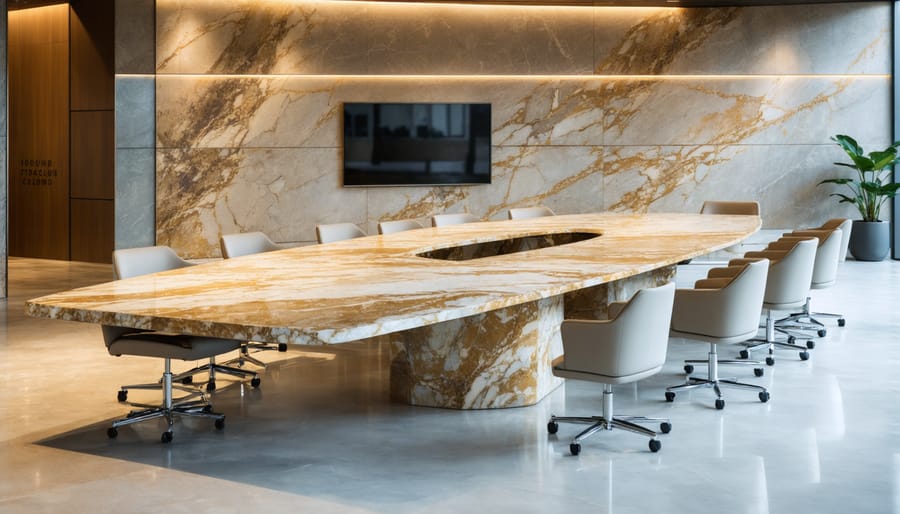
Break Rooms and Collaborative Spaces
Break rooms and collaborative spaces demand surfaces that withstand constant interaction while maintaining an inviting atmosphere. Natural stone excels in these high-traffic zones, offering both practical durability and aesthetic warmth that encourages team interaction.
Granite and quartzite countertops prove ideal for break room installations, resisting scratches from utensils, heat from coffee makers, and stains from daily spills. Their non-porous surfaces when properly sealed ensure hygienic food preparation areas that meet commercial health standards. Marble backsplashes add sophistication to beverage stations, though they require more maintenance in areas prone to acidic liquids.
For collaborative seating areas, limestone and travertine tabletops create an approachable feel that balances professionalism with comfort. These stones develop a lived-in patina over time, actually improving their character rather than showing wear. Stone benches in casual meeting zones provide durable, easy-to-clean seating that withstands years of use.
The key advantage in these multipurpose spaces is stone’s ability to transition seamlessly between functional and social settings. A well-chosen natural stone installation communicates that employee wellness matters while delivering the performance metrics facility managers require for long-term value.
Exterior Applications and Landscaping
Natural stone’s versatility extends seamlessly from interior spaces to exterior applications, creating unified design narratives that blur the boundaries between indoor and outdoor environments. Building facades clad in granite, limestone, or sandstone establish commanding street presence while providing exceptional weather resistance and thermal performance. These materials age gracefully, developing character over time rather than deteriorating like synthetic alternatives.
Outdoor seating areas benefit from stone’s durability and low maintenance requirements. Limestone benches, granite tabletops, and travertine ledges withstand heavy use and extreme weather conditions while maintaining their aesthetic appeal. Their natural thermal mass helps moderate temperature fluctuations, creating more comfortable gathering spaces year-round.
Pathways and pedestrian zones constructed from bluestone, slate, or quartzite pavers offer superior slip resistance and longevity compared to poured concrete or pavers. These surfaces handle constant foot traffic without showing significant wear, making them ideal for high-traffic commercial entrances and plaza areas.
Water features incorporating natural stone—from cascading fountain walls to reflecting pool edges—add sensory richness to commercial landscapes. The interplay between water and stone’s varied textures creates dynamic visual experiences that enhance property value and visitor engagement while requiring minimal ongoing maintenance.
Performance Characteristics That Matter in Commercial Settings
Durability Under High-Traffic Conditions
Natural stone’s performance in high-traffic commercial environments varies significantly by type, making selection critical for long-term success. Granite stands as the most durable option, with exceptional scratch and impact resistance that makes it ideal for lobbies, retail spaces, and corridors experiencing constant foot traffic. Its dense composition resists wear even after decades of use, maintaining its polished finish with minimal maintenance.
Marble, while elegant, requires more consideration in high-traffic areas. Though susceptible to etching from acidic substances and showing wear patterns over time, honed or textured finishes can mask minor imperfections better than polished surfaces. Many designers reserve marble for feature walls or lower-traffic zones within commercial spaces.
Limestone and travertine occupy the middle ground—durable enough for moderate traffic when properly sealed, yet requiring more attentive maintenance than granite. These stones develop a natural patina that many find appealing, particularly in hospitality settings where character adds warmth.
Quartzite rivals granite in hardness and scratch resistance, increasingly popular for demanding applications. Slate offers excellent slip resistance and durability for flooring, though its layered structure requires proper installation to prevent delamination. Regular sealing and appropriate finish selection significantly enhance any stone’s longevity in commercial environments.
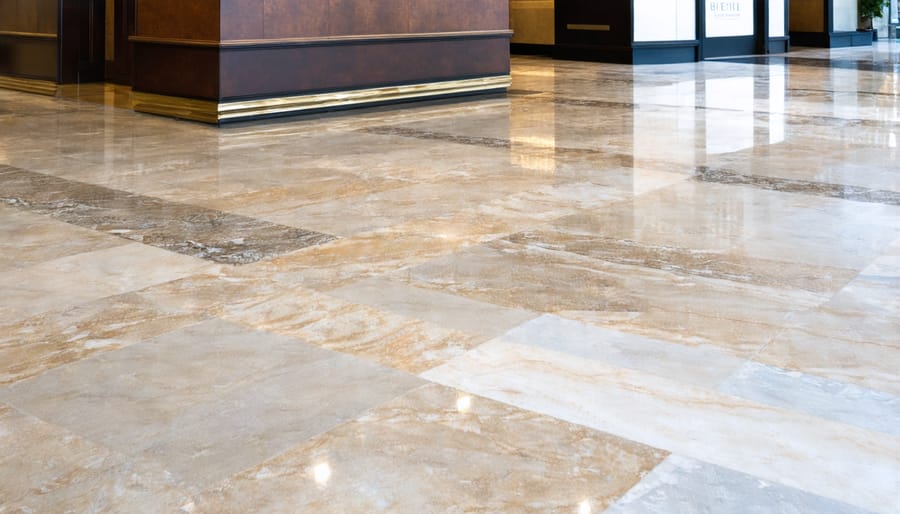
Maintenance Requirements for Commercial Use
Commercial natural stone installations demand structured maintenance protocols to preserve their appearance and longevity. Facility managers should establish daily cleaning routines using pH-neutral cleaners specifically formulated for natural stone—acidic or alkaline products can etch surfaces and deteriorate sealants over time.
Sealing schedules vary by stone type and traffic levels. High-traffic marble and limestone typically require resealing every 6-12 months, while denser granite may extend to 12-18 months. Conduct simple water-drop tests quarterly: if water absorbs rather than beads, resealing is necessary. Document all maintenance activities to track performance patterns and budget accordingly.
For lobbies and high-visibility areas, professional deep cleaning should occur semi-annually, addressing grout lines and removing embedded dirt that daily maintenance misses. Train cleaning staff on proper techniques—microfiber mops and appropriate dilution ratios prevent common damage from over-wetting or harsh chemicals.
Budget considerations should include annual professional inspections to identify early signs of wear, minor repairs to prevent escalation, and periodic honing or polishing to restore finish. Proactive maintenance costs significantly less than remedial restoration, typically representing 2-3% of the initial installation investment annually while protecting the stone’s aesthetic and functional value for decades.
Indoor Air Quality and Health Benefits
Natural stone stands out as a superior choice for commercial workspaces when it comes to maintaining healthy indoor air quality. Unlike synthetic materials that can release volatile organic compounds (VOCs) and other harmful chemicals into the air, natural stone is inherently inert and non-toxic. Materials like granite, marble, and limestone emit zero VOCs, making them ideal for enclosed office environments where air quality directly impacts employee wellbeing and productivity.
This natural composition means that natural stone in commercial design contributes to LEED certification goals and supports green building initiatives. Stone surfaces don’t harbor allergens, mold, or bacteria when properly sealed and maintained, creating cleaner workspace environments. The material’s durability also eliminates the need for frequent replacements that generate construction dust and introduce new materials with potential off-gassing concerns.
For businesses prioritizing employee health—particularly important in post-pandemic workspace planning—natural stone offers peace of mind. Its hypoallergenic properties and resistance to microbial growth make it especially valuable in high-traffic areas, break rooms, and reception spaces where air quality concerns are paramount.
Choosing the Right Stone for Your Commercial Project
Granite vs. Marble vs. Limestone: Commercial Applications
Selecting the right natural stone for commercial applications requires balancing aesthetics, durability, and maintenance demands. Each stone type offers distinct advantages depending on your project’s specific requirements.
**Granite** excels in high-traffic environments where durability is paramount. Its exceptional hardness and resistance to scratching make it ideal for hotel lobbies, airport terminals, and retail flooring. Corporate kitchen countertops and food service areas benefit from granite’s non-porous nature when properly sealed, resisting stains and bacterial growth. The stone’s minimal maintenance requirements translate to lower long-term operational costs, making it the go-to choice for budget-conscious facility managers overseeing large commercial spaces.
**Marble** commands attention in prestige applications where visual impact justifies higher maintenance. Executive office lobbies, luxury hotel reception areas, and upscale restaurant interiors leverage marble’s timeless elegance to communicate sophistication. However, its susceptibility to etching from acidic substances limits kitchen use. Marble performs best in climate-controlled interior spaces with moderate foot traffic, such as boardrooms and executive suites, where its beauty can be preserved through regular professional maintenance.
**Limestone** offers warmth and versatility for mid-range commercial projects. Its softer appearance suits hospitality venues, boutique retail spaces, and professional office buildings seeking an approachable yet refined aesthetic. While more porous than granite, limestone works well for interior walls, feature elements, and lower-traffic flooring. Healthcare facilities appreciate limestone’s calming properties, though high-traffic zones require alternative materials. Budget considerations often favor limestone for accent walls and decorative applications where dramatic durability isn’t essential.
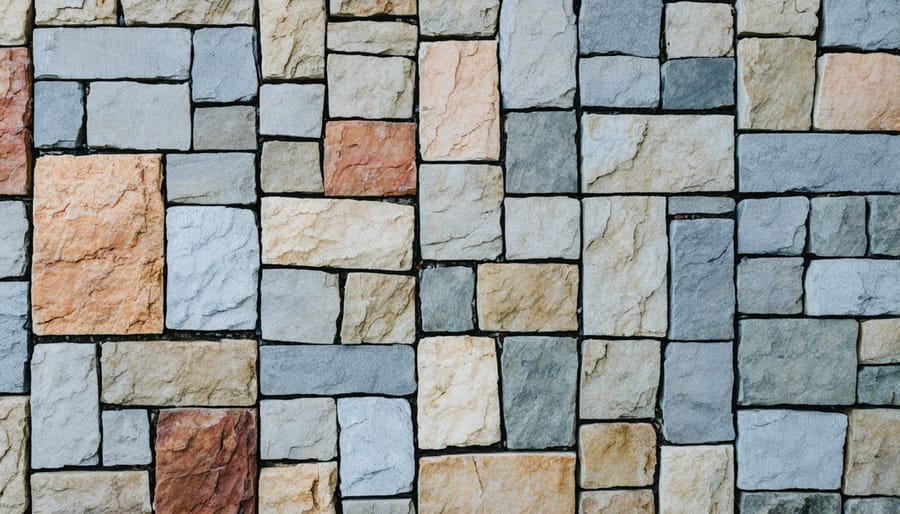
Finishes That Balance Beauty and Functionality
The surface finish you select for natural stone directly impacts both safety and longevity in commercial environments. Each finish type offers distinct advantages depending on traffic patterns, moisture exposure, and aesthetic goals.
**Polished finishes** deliver mirror-like reflectivity and vivid color depth, making them ideal for low-traffic areas like elevator cabs, reception desk fronts, and feature walls. However, they show scratches more readily and can become slippery when wet, limiting their use in high-traffic corridors or restroom applications.
**Honed finishes** provide a matte, satin-smooth surface that conceals minor scratches and etching better than polished surfaces. This makes honed stone particularly suitable for commercial flooring in moderate-traffic areas, conference room tables, and bathroom vanities. The slight texture offers improved slip resistance without sacrificing the stone’s natural elegance.
**Leathered finishes** retain the stone’s natural color while adding subtle texture through a specialized brushing process. This finish excels at hiding fingerprints, water spots, and daily wear—critical considerations for commercial kitchen countertops, collaborative workspace surfaces, and hospitality applications where maintenance efficiency matters.
**Textured finishes** including flamed, brushed, and tumbled surfaces maximize slip resistance, making them essential for exterior walkways, pool decks, and high-moisture interior zones. The pronounced texture does collect more dirt, requiring more frequent cleaning protocols.
Selecting appropriate stone finishes requires balancing your design vision with practical performance needs. Consider consulting finish samples in your actual lighting conditions, and test slip resistance ratings against your building codes before finalizing specifications.
Real-World Commercial Stone Installations
Tech Company Headquarters: Modern Minimalism
A Silicon Valley tech innovator transformed their 50,000-square-foot headquarters using floor-to-ceiling book-matched Calacatta marble slabs to embody their brand values of precision and innovation. The design team specified large-format slabs—some measuring 10 feet by 5 feet—to minimize grout lines and create seamless visual continuity throughout the open-plan workspace.
The lobby features a dramatic 20-foot wall of continuous stone veining that immediately communicates sophistication to clients and recruits. In collaborative spaces, honed white marble surfaces provide glare-free backdrops for video calls while maintaining a premium aesthetic. The stone’s natural cooling properties also complement the building’s sustainable HVAC system, reducing energy costs by an estimated 12%.
This approach to commercial stone installations required careful coordination between architects, fabricators, and structural engineers to ensure proper support for the heavy slabs. The result demonstrates how natural stone creates timeless environments that balance cutting-edge design with organic warmth—a particularly valuable combination in technology-focused workplaces where human connection matters.
Law Firm Renovation: Traditional Elegance
A prestigious downtown law firm sought to communicate trustworthiness and permanence through their office redesign, selecting natural stone as the cornerstone of their renovation strategy. The design team specified Calacatta marble for the reception area flooring and feature wall, its distinctive grey veining creating an immediate impression of refinement. The stone’s luminous quality enhanced natural light while establishing the firm’s commitment to quality from the first client interaction.
Partner offices featured honed Absolute Black granite conference tables and credenzas, chosen for their durability and sophisticated matte finish. Unlike polished surfaces that show fingerprints, the honed granite maintained its appearance throughout demanding workdays while projecting authority during client meetings.
Common areas incorporated Book-Matched Emperador marble wall panels, where adjacent slabs were opened like a book to create mirror-image patterns. This installation technique showcased the stone’s natural artistry while demonstrating attention to detail that paralleled the firm’s approach to legal work.
The project required careful coordination with stone fabricators to ensure consistent color selection across multiple slabs and precise installation tolerances for seamless transitions. The result transformed functional office space into an environment that actively reinforced brand positioning, with the stone’s inherent permanence metaphorically representing the firm’s enduring client relationships.
Working with Stone Fabricators and Installers
Questions to Ask Before Starting Your Project
Before committing to a natural stone project, have detailed conversations with your stone supplier and installation contractor. Start by discussing **sourcing and material availability**—ask where the stone originates, whether you can view the actual slabs before purchase, and how natural variations will be managed across large installations. Inquire about **lead times** for both material procurement and fabrication, as natural stone often requires 6-12 weeks from selection to delivery, particularly for exotic varieties or large commercial quantities.
Understand the **installation methodology** specific to your application. Will the stone be mechanically anchored, adhered, or supported by a structural system? What substrate preparation is required? Request information about the installer’s experience with similar commercial projects and ask to see references.
Address **warranty coverage** comprehensively. Clarify what’s covered under material warranties versus installation guarantees, typical duration of coverage, and exclusions. Ask about post-installation support, recommended maintenance protocols, and whether the contractor provides periodic sealing services. Finally, discuss **project timeline contingencies**—natural stone work can face delays due to material defects discovered during fabrication or unforeseen site conditions, so establish clear communication protocols and realistic scheduling expectations upfront.
Timeline Expectations for Commercial Projects
Commercial natural stone projects require careful timeline planning to ensure successful outcomes. From initial stone selection to final installation, expect a minimum of 8-12 weeks for standard projects, though complex installations may extend to 16-20 weeks.
The selection phase typically takes 2-3 weeks, allowing time to review samples, approve slabs, and finalize specifications. Material procurement adds another 4-6 weeks, particularly for imported stones or custom finishes. Fabrication requires 2-3 weeks depending on project complexity and shop capacity.
Installation timelines vary based on square footage and intricacy, ranging from one week for simple applications to several weeks for extensive flooring or intricate wall features. Always incorporate a 15-20% buffer for potential delays—supply chain disruptions, weather conditions affecting quarries, or unexpected site preparation needs can impact schedules.
Coordinating with other trades is critical in commercial settings. Stone installation often occurs mid-to-late in construction sequences, requiring precise scheduling to avoid conflicts. Early engagement with stone specialists during design development helps identify realistic timelines and prevents costly delays. For time-sensitive projects, consider domestic stone sources and maintaining relationships with fabricators who can prioritize urgent work.
Natural stone continues to set the standard for commercial workspaces that demand lasting quality, visual impact, and authentic character. Throughout this guide, we’ve explored how stone delivers unmatched durability in high-traffic environments, creates memorable first impressions in reception areas, and maintains its beauty with straightforward maintenance protocols. The material’s versatility spans from grand lobby installations to intimate executive spaces, proving its adaptability across diverse commercial applications.
When evaluating stone for your next project, remember the key decision factors: matching stone type to specific usage demands, understanding the total cost of ownership rather than just initial investment, and partnering with experienced fabricators who can execute your vision properly. The case studies we’ve examined demonstrate that well-planned stone installations continue performing exceptionally for decades, making them sound financial decisions that enhance property value over time.
Natural stone isn’t merely a design choice—it’s an investment in your workspace’s longevity, your brand’s image, and your occupants’ daily experience. Whether you’re renovating a historic building or creating a contemporary office environment, stone offers timeless appeal that engineered materials simply cannot replicate. As you move forward with your commercial project, consider stone not as an extravagance, but as the strategic choice for spaces that need to perform beautifully for years to come. The authenticity and permanence of natural stone speak volumes about the quality standards you uphold.





